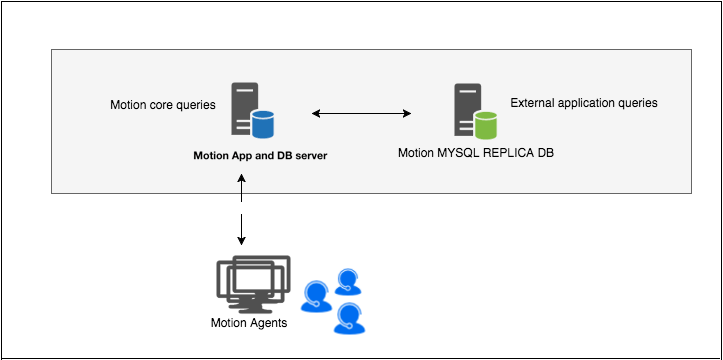Requirements
Server side requirements
XCALLY Motion can be deployed on a dedicated on-premise server, virtual machine or on the cloud. XCALLY Motion runs on a CentOS machine and the server specification depend on the type of service you are offering and the number of agents in the call center.
Operating System
Debian GNU/Linux 10 "Buster" - 64 bit (netinst)
Important: The following requirements are general guidelines for getting started with XCALLY based on concurrent agents.
Keep in mind that during your XCALLY operations some other parameters must also be considered, such as the maximum number of queues per agent, IVR complexity, the use of external APIs etc ...: the growth of any of these parameters could lead to redefine server requirements.
Recommended minimum server sizes:
Voice (Plus) | Voice + Dialer (Dialer-gold) | Omnichannel (Omni-gold) | Full (Ultimate) | |
|---|---|---|---|---|
Up to 30 agents** | RAM: 2 GB CPU: 2 HDD: 32 GB | RAM: 4 GB CPU: 4 HDD: 32 GB | RAM: 4 GB CPU: 4 HDD: 32 GB | RAM: 4 GB CPU: 4 HDD: 32 GB |
Up to 100 agents** | RAM: 4 GB CPU: 4 HDD: 60 GB | RAM: 6 GB CPU: 6 HDD: 60 GB | RAM: 6 GB CPU: 6 HDD: 60 GB | RAM: 6 GB CPU: 6 HDD: 60 GB |
100 + agents** | RAM: 4 GB CPU: 4 HDD: 100 GB | RAM: 6 GB CPU: 6 HDD: 100 GB | RAM: 6 GB CPU: 6 HDD: 100 GB | RAM: 8 GB CPU: 8 HDD: 100 GB |
** concurrent agents
N.B. More RAM or HDD space is needed using complex IVR scripts (DB access and custom scripts) or if you need to store many logs and call recordings.
Remember to configure your system SWAP AREA properly (at least the double of the RAM)
If you are planning to use complex IVR scripts (DB access and custom scripts) consider to double the RAM.
If you need to store a lot of logs and call recordings, please evaluate a large HDD space. Calls recorded in wav format need about 1MB per minute, in GSM format about 300k per minute. CentOS default root partition is 50 GB, if you need more space set partition size manually during installation.
For security reasons, please consider to install a proper firewall in front of your XCALLY server, especially if it is deployed on the Cloud.
Licenses
Please note that any change of any kind applied on your XCALLY server (i.e. CPU, memory, HDD, network etc…) can invalidate your XCALLY assigned license: for this reason any move and change of your XCALLY server must be carefully planned and notified to the XCALLY team.
How to scale
Scaling
For large scalable deployments and to be able to interact with the Motion DB from external application - without affecting the operation - we suggest at least 2 or 3 Linux CentOS7.X servers, like in the following examples.
Recommended architecture if you need to scale over 50 agents:
Recommended architecture if you need to scale over 200 agents:
Please contact our XCALLY Team for help and more details about this scalable deployment solution.
Client side requirements
Agents can manage any interactions coming from multiple channels using the same unified user interface.
To manage voice calls, agents can use Motion Phonebar, WebRTC bar or external SIP clients.
To use the Phonebar:
- OS: Windows 7, 8, 10 with .Net 3.5 installed
To use external SIP clients:
- OS: MAC OS (Yosemite/El Capitan/Sierra/High Sierra/Mojave/Catalina), Linux OS, MS Windows 7, 8,10 (refer to OS requirements of the SIP clients)
To use the WebRTC Bar:
- Browsers: Opera, Google Chrome, Safari
- OS: MAC OS (Yosemite/El Capitan/Sierra/High Sierra/Mojave/Catalina), MS Windows 7, 8, 10, Linux OS, Chrome OS, Chromium OS
To run the Omnichannel web interface:
- Browsers: Google Chrome, Mozilla Firefox, MS Edge
Browser compatibility
In particular, the application has been tested with minimum Google Chrome (v46) and Firefox (v41.0.2) on Windows (8.1/10) and Mac OS (Yosemite/El Capitan/Sierra/High Sierra).
You can use Microsoft Edge 25.10586 (tested on Windows 10), for external SIP clients and Phonebar only
If you use Firefox, please enable the Web Components feature:
https://developer.mozilla.org/en-US/docs/Web/Web_Components#Enabling_Web_Components_in_Firefox




